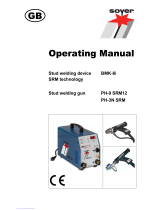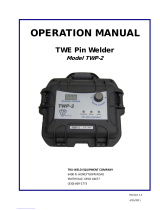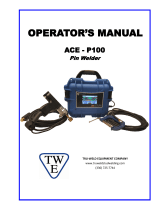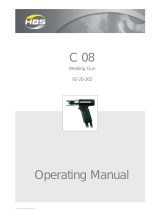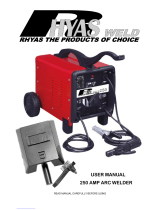Page is loading ...

Operating Instructions
BMK-16i
Stud Welder

BMK-16i
2

BMK-16i
3
Operating Instructions
BMK-16i
Stud Welder
Serial number*
BMK-16i stud welder _________________________
Please enter the serial number here to have it immediately
available if you need service support.
Type table for BMK-16i stud welder
Order No. Code designation Note
P01340 BMK-16i Standard device (3 x 400 volt power supply)
P01341 BMK-16i automatic Standard device (3 x 400 volt power supply)
with automatic set for stud reload
Heinz Soyer Bolzenschweißtechnik GmbH
Etterschlag
Inninger Straße 14
82237 Wörthsee
Tel.: +49 (0) 8153 - 885 - 0
Fax: +49 (0) 8153 – 8030
www.soyer.de

BMK-16i
4

BMK-16i
5
Congratulations on purchasing the BMK-16i SOYER stud welder.
You have made an excellent choice. Your BMK-16i SOYER stud welder was specially
developed for the high-speed fastening of SOYER welding studs in compliance with
DIN EN ISO 13 918 on metallic, weldable workpieces.
SOYER® is a registered trade mark of Heinz Soyer Bolzenschweißtechnik GmbH.
It is prohibited to transmit or reprint this document, as well as to utilize or disclose its
contents, unless this has been expressly granted.
Non-compliance with this regulation is liable to compensation. All rights reserved,
particularly in the case of a patent grant or a GM registration.
We have verified that the contents of this pamphlet correspond to the hard- and
software described. Deviations, however, cannot be excluded so that we cannot
warrant for absolute compliance.
The illustrations contained in this instruction manual can vary in some details from
your product. This, however, has no influence on the handling of the machine.
The data in this documentation, however, have been verified regularly and necessary
corrections will be incorporated in future impressions. We appreciate any suggestions
for improvement.
Date of issue: December 01, 2002
Xxxxxxxx 03-06-03
© Heinz Soyer Bolzenschweißtechnik GmbH 2002 · All rights reserved
Printed in the Federal Republic of Germany

BMK-16i
6

BMK-16i
7
Heinz Soyer Bolzenschweißtechnik GmbH
Inninger Straße 14
82237 Wörthsee
EC Conformity Declaration
in compliance with EC Directive on Machinery 89/392/EEC, appendix II A
We herewith declare that the machine described in the following and the version available on
the market correspond in its design and construction to the fundamental safety and health
requirements stipulated by EC Directive on Machinery. Any modification of this machine
without confirmation shall automatically annul this declaration.
Designation of machine : Stud Welder
Machine type : BMK-16i
Machine no. : ___________________________________
Applicable EC directives : EC Directive on Machinery (89/392/EEC) in the version
91/368/EEC
EC Directive on Low Voltage (73/23/EEC)
EC Directive on Electromagnetic Compatibility
(89/336/EEC)
Applied harmonised EN 292 - 1 and EN 292 - 2, EN 60 204 - 1
standards, in particular : EN 60 974 - 1
Applied national standards VBG 1, VBG 4, VBG 5,
and technical specifications,
in particular : VDE 0544
Date : August 01, 2002
Producer’s signature : ___________________________________
Signer’s function : Technical Management

BMK-16i
8

BMK-16i
9
Table of contents
1 General............................................................................................................... 12
1.1 The following should be principally observed.............................................................. 12
1.2 Application ................................................................................................................... 13
1.3 Information on the product........................................................................................... 13
1.4 Type plate.................................................................................................................... 13
1.5 Information on the documentation............................................................................... 13
1.5.1 Chapters of operating instructions ............................................................................... 14
1.5.1 Information on operating instructions........................................................................... 14
1.5.2 Conduct in the case of malfunctions............................................................................ 15
1.6 Contacts and service address .....................................................................................15
2 Description of stud welder............................................................................... 16
2.1 Short-cycle drawn arc technology................................................................................ 16
2.2 Stud welding ................................................................................................................ 17
2.2.1 Drawn arc welding with shielding gas.......................................................................... 17
2.2.2 Drawn arc welding with ceramic ferrules ..................................................................... 17
2.3 Manual electric welding / TIG welding......................................................................... 18
2.3.1 Manual electric welding (electrode welding)................................................................ 18
2.3.2 TIG welding.................................................................................................................. 19
2.4 View / Dimensions ....................................................................................................... 20
2.5 Technical data.............................................................................................................. 21
2.6 Circuit diagram of BMK-16i.......................................................................................... 22
2.6.1 Wiring diagram............................................................................................................. 22
2.6.2 Wiring diagram of modules .......................................................................................... 22
2.7 BMK-16i interfaces....................................................................................................... 23
2.7.1 CNC interface .............................................................................................................. 23
3 Safety instructions ........................................................................................... 24
3.1 Description of reference signs in the operating instructions........................................ 24
3.2 Staff qualification and training...................................................................................... 25
3.3 Dangers in the case of non-compliance with safety instructions................................. 25
3.4 Safety-conscious working............................................................................................ 25
3.5 Safety instructions for the operator/user...................................................................... 25
3.6 The following should be observed before starting the system…................................. 26
3.7 Before starting to weld.................................................................................................26
3.8 Safety precautions at installation site .......................................................................... 26
3.9 Working with the stud welding equipment ................................................................... 27
3.10 Safety instructions for maintenance, inspection and assembly................................... 27
3.11 Unauthorized retrofit and spare parts production........................................................ 27
3.12 Inadmissible operating methods.................................................................................. 27
3.13 Stopping the stud welder............................................................................................. 28
3.14 The “S” symbol............................................................................................................. 28

BMK-16i
10
4 Installation of stud welder ............................................................................... 29
5 Start-up.............................................................................................................. 31
5.1 Front and rear view......................................................................................................31
5.1.1 Operating elements...................................................................................................... 32
5.1.2 Display elements.......................................................................................................... 33
5.1.3 LED display (item 4, chapter 5.1) ................................................................................ 34
5.1.4 Connecting elements ................................................................................................... 35
5.1.5 Symbols ....................................................................................................................... 36
5.2 Preparation for start-up................................................................................................ 37
5.2.1 Earth connection .......................................................................................................... 37
5.2.2 Connection of stud welding gun................................................................................... 38
5.2.3 Gas supply ................................................................................................................... 38
5.2.4 Power supply ............................................................................................................... 39
5.3 Adjustment of operating modes................................................................................... 39
5.3.1 Starting the stud welder ............................................................................................... 39
5.3.2 Operating modes / parameters .................................................................................... 39
5.4 Special functions.......................................................................................................... 45
5.4.1 Special function "Erasing the working storage" ........................................................... 45
5.4.2 Special function "Display of operating counter"........................................................... 45
5.4.3 Special function "Setting the type of feeder and its functions". ................................... 46
5.4.4 Special function "Selection of language. Display of software version number"........... 47
5.4.5 Special function "Setting the feeder operation" ........................................................... 48
6 Operation........................................................................................................... 49
6.1.1 Setting welding parameters for standard welding operation........................................ 49
6.1.2 Welding parameters for welding operation .................................................................. 52
6.1.3 Minimum sheet thickness when welding with drawn arc operation ............................. 52
6.2 Welding operation with shielding gas .......................................................................... 53
6.2.1 Preparation of gas supply ............................................................................................ 54
6.2.2 Instructions for welding with shielding gas .................................................................. 55
6.3 Welding operation with ceramic ferrules...................................................................... 55
6.3.1 Instructions for welding with ceramic ferrules.............................................................. 56
6.4 Stopping the stud welder............................................................................................. 56
7 Quality control (stud welding)......................................................................... 57
7.1 General........................................................................................................................57
7.2 Demands on the company........................................................................................... 57
7.3 Test execution.............................................................................................................. 58
7.3.1 Production of samples ................................................................................................. 58
7.3.2 Visual inspection .......................................................................................................... 58
7.3.3 Bend test...................................................................................................................... 59
7.3.4 Tensile test................................................................................................................... 60
8 Maintenance...................................................................................................... 61
8.1 Important instructions................................................................................................... 61
8.2 Cleaning.......................................................................................................................61
8.2.1 Detergents ................................................................................................................... 61
8.3 Replacement of components.......................................................................................62
9 Spare parts list for BMK-16i............................................................................. 63
9.1 Spare parts for BMK-16i .............................................................................................. 63
10 Troubleshooting ............................................................................................... 64
10.1 Malfunctions................................................................................................................. 65
11 Transport and storage...................................................................................... 68
12 Terms of warranty............................................................................................. 68

BMK-16i
11
13 List of standards and guidelines .................................................................... 69
Appendix A /
Adjustment of short-cycle drawn arc welding guns Appendix A

BMK-16i
12
1 General
1.1 The following should be principally observed...
??
With this stud welder you have purchased a product which
• is state-of-the-art technology
• fully complies with the current safety requirements and
• enables successful working.
Before installing the stud welder, please observe the following:
• Store the operating instructions in a place accessible to every operator
• Ensure that the respective operator has read and understood the operating
instructions prior to installation. Each operator should confirm this per
signature.
• Prevent the stud welder being operated by unauthorized personnel
• Only trained personnel may operate the stud welder
DANGER
Persons with pacemakers must not operate the stud welding
equipment and must not stay near it while it is running. Ensure
that the stud welding equipment is not operated near
electronically sensitive life-supporting equipment, such as in
intensive care units in hospitals.
CAUTION
Keep sufficient distance from electronic devices. When stud
welding, highly intensive electromagnetic fields are created
which may permanently damage these devices (e.g. television
sets).
• Moreover, please observe the safety instructions in chapter 3.
• Call a doctor in case of an accident.

BMK-16i
13
1.2 Application
The BMK-16i SOYER stud welder for short-cycle drawn arc welding allows SOYER
threaded studs as per DIN EN ISO 13918 and ranging from M3 – M16 RD (MR) or Ø 2
– 13mm (studs, shear connectors, concrete anchors) made of plain, stainless and
heat-resistant steel to be welded on different workpieces (sheets, tubes, steel girders
etc.).
Usually round pins with or without thread are welded. You may also weld fasteners
with different cross-sectional shapes. For this purpose, however, special stud holders
and ceramic ferrules or gas shrouds are required.
With the BMK-16i SOYER stud welder it is also possible to weld studs of other metallic
materials than steel. It is, however, necessary to first carry out experimental welds and
to inspect them.
Manual electric welding (electrode welding) and TIG welding is also possible to a
limited extent.
If you need consultation or assistance in solving problems, please contact either our
parent company or our field engineers.
1.3 Information on the product
Manufacturer Heinz Soyer Bolzenschweißtechnik GmbH
Etterschlag
Inninger Straße 14
D-82237 Wörthsee
Tel.: +49 (0) 8153-885-0
Fax: +49 (0) 8153-8030
www.soyer.de
Product designation BMK-16i Stud Welder
Country of origin Germany
1.4 Type plate
The type plate is located on the rear side of the stud welder. It contains the following
information:
• Manufacturer’s name
• Address of manufacturer or agency
• Country of origin
• Product designation
• Mains connection values
• Performance data
• Production number / year of construction
1.5 Information on the documentation
The following operating instructions are supplied with the BMK-16i stud welder:
• Operating instructions for BMK-16i stud welder
Order no.: P00229
For repeat-orders please contact your responsible service office or our parent
company. Please refer to chapter 1.6.

BMK-16i
14
1.5.1 Chapters of operating instructions
The operating instructions describe the start-up and operation of the BMK-16i stud
welder under normal conditions.
The present operating instructions of the BMK-16i stud welder comprise the following
chapters in detail:
• Chapter 1 General
• Chapter 2 Description of stud welder
• Chapter 3 Safety instructions
• Chapter 4 Installation of stud welder
• Chapter 5 Start-up
• Chapter 6 Operation
• Chapter 7 Quality control
• Chapter 8 Maintenance
• Chapter 9 Spare parts list for BMK-16i
• Chapter 10 Troubleshooting
• Chapter 11 Transport and storage
• Chapter 12 Terms of warranty
• Chapter 13 List of standards and guidelines
1.5.1 Information on operating instructions
Legal relationship
We draw your attention to the fact that the contents of these operating instructions are
neither part of any former or existing arrangement, pledge or legal relationship nor are
designed for modifying the latter. All obligations of Heinz Soyer Bolzenschweißtechnik
GmbH result from the respective contract of purchase which also comprises the
complete and generally valid warranties. These contractual warranty terms are neither
extended nor restricted by the implementation of these operating instructions.
CAUTION
Do not carry out any actions on the stud welder without specifically
knowing the operating instructions or the respective part. Ensure that only
qualified personnel familiar with the operating instructions and the
necessary technical activities (training!) operate the system.

BMK-16i
15
1.5.2 Conduct in the case of malfunctions
If malfunctions occur, first try to detect and eliminate the causes according to the list in
chapter 10 "Troubleshooting" of the operating instructions. In all other cases, please
contact our service department.
If you require our service, please make sure that you supply us with the following
information:
• Customer number
• Product designation
• Serial number
• Year of construction
• Options
• Material of stud and workpiece
• Stud dimensions
This information will help us both to save time and unnecessary costs, e.g. caused by
delivering the wrong spare parts.
1.6 Contacts and service address
If you have any questions regarding the operation of the stud welding system, retrofits
or if you require service, please contact your responsible service office or the following
address:
Heinz Soyer Bolzenschweißtechnik GmbH
Etterschlag
Inninger Straße 14
D-82237 Wörthsee
Tel.: +49 (0) 8153-885-0
Fax: +49 (0) 8153-8030
www.soyer.de

BMK-16i
16
2 Description of stud welder
2.1 Short-cycle drawn arc technology
Illustration 1: Short-cycle drawn arc technology
The BMK-16i SOYER stud welder runs according to the principle of short-cycle drawn
arc stud welding. For detailed information, please refer to the following regulations:
• DIN EN ISO 14555, "Arc welding of metallic materials“
• DVS Information Sheet 0902, "Drawn arc welding“
When welding, the stud is positioned on the workpiece. The preweld current is ignited
and the stud is lifted off the workpiece. The subsequent ignition of the main current
creates a molten pool between stud and workpiece. The stud immerses in the liquid
molten pool and the material solidifies.
This method allows manual, semi-automatic and fully automatic inseparable welding
of threaded stud fasteners, pins, balls, T-bolts, tapped studs, insulating pins, special
studs and many other fasteners made of steel, CrNi steel, heat-and acid-resisting
steel with the workpieces. Conditionally it is also possible to weld nickel and titanium
depending on the respective requirements. Standard studs for drawn arc and
capacitor discharge welding in compliance with DIN EN ISO 13918 can be welded
without requiring any auxiliary aids. The application of shielding gas or ceramic
ferrules is recommended for studs with a diameter of more than 6 mm to prevent pore
formation and to optimise the formation of bulges.
The standard BMK-16i stud welder is suitable for operation with shielding gas and
ceramic ferrules. A D.C. power supply with inverter technology provides the welding
current. The weld duration and welding current can be selected. Owing to the low
penetration depth of about 0.4 mm, the short-cycle drawn arc method can be applied
from a sheet thickness of 0.6 mm on. It guarantees particularly safe, uniform and
reproducible stud welded joints without high requirements to setting accuracy and stud
tip quality. Application is especially recommended for workpieces with difficult surface
characteristics, e.g. oil, grease, zinc and other galvanic treatments as well as rolling
scale, filling materials, forging scale, oxide films, etc. The ratio of minimum sheet
thickness and stud diameter amounts to 1:8.

BMK-16i
17
IMPORTANT INFORMATION
Ensure that the surface is electroconductive.
Abrase hot galvanized parts.
The following welding methods are possible when using the BMK-16i SOYER short-
cycle drawn arc stud welder:
• Short-cycle drawn arc stud welding without shielding gas and ceramic ferrules.
• Drawn arc stud welding using ceramic ferrules as auxiliary aid.
• Drawn arc stud welding using shielding gas as auxiliary aid.
• Manual electric welding (electrode welding)
• TIG welding
Preferably use shielding gas as auxiliary aid. The use of ceramic ferrules as auxiliary
aid, however, is necessary when carrying out particularly critical welding works as e.g.
welding works during which the gun has to be held in a horizontal position or above
the head.
2.2 Stud welding
The PH-2L stud welding gun with control cable and shielding gas equipment is the
standard gun to be connected to the BMK-16i stud welder. Optionally you may also
connect the PH-3N, PH-3L and PK-0K stud welding guns. These operating
instructions only refer to the BMK-16i stud welder.
For information regarding the stud welding guns or welding heads to be used and their
setting, please refer to the respective operating instructions.
2.2.1 Drawn arc welding with shielding gas
With this method, a gas mixture containing 82% of Argon and 18% of CO 2 (e.g.
Corgon®18*) is used as auxiliary aid.
This shielding gas protects the welding point from the atmosphere and simultaneously
supports the weld pool. Moreover, it ensures a concave fillet weld upset formation with
a blank metallic surface, thus reducing the risk of corrosion and obtaining an improved
dynamic behaviour of the welded joint.
An accurate bulging, to scale or in a calibrated or reproducible type, is not possible
when welding with shielding gas without using any auxiliary aid. Stud welding with
shielding gas can be carried out at much shorter intervals as no ceramic ferrules have
to be fitted and removed in each welding process.
*) Corgon®18 is a gas mixture of Linde AG in D-82049 Höllriegelskreuth
R
2.2.2 Drawn arc welding with ceramic ferrules
The ceramic ferrule fulfils the following functions:
• It centres the electric arc.
• It protects the welding point from the atmosphere.
• It ensures the exact formation of the weld upset.
• It prevents too rapid cooling of the weld pool.
• It partially protects against spraying sparks.
To ensure a perfect and accurate weld upset, each stud requires a ceramic ferrule
matching its diameter and shape. After every welding process, the ceramic ferrule
must be knocked down and replaced by a new one.
Usually this method allows you to weld in any position.

BMK-16i
18
IMPORTANT INFORMATION
Ensure ceramic ferrules are absolutely dry.
2.3 Manual electric welding / TIG welding
Instructions on application
These operating instructions only describe the function "stud welding".
Instructions on manual electric welding / TIG welding can be obtained from the
respective manufacturers of the necessary accessories.
Table for electrical characteristic values as per DIN EN 60974-1
10)
40 A / 21.6 V up to 300 A / 32 V
6)
8)
______
- - - - - - 11)
X
11b)
60 %
11c)
100 %
12)
I 2
12b)
300 A
12c)
200 A
7)
9)
U0 = 85 V 13)
U 2
13b)
32 V
13)
28 V
Field 6 Graphical symbol for welding process “Covered-Electrode Manual Arc
Welding"
Field 7 Symbol for welding current sources which are suitable for welding in
an environment of increased electrical danger.
Field 8 Symbol for direct current.
Field 9 Dimensioning value of open-circuit voltage in volt.
Field 10 Lowest and highest power range.
Field 11 Symbol for operating time.
Field 12 Symbol for dimensioning value of welding current.
Field 13 Symbol for standardized operating voltage.
Field 11b,c Value of operating time in %.
Field 12b,c Dimensioning value of welding current in ampere.
Field 13b,c Value of standardized operating voltage in volt.
2.3.1 Manual electric welding (electrode welding)
"Electrode welding" allows simple welding works with covered electrodes (electrode
holders are not included in delivery)
Please pay attention to the following:
• Stud welding technology necessitates that the electrode holder is connected
to the negative pole. Polarity may, however, be inverted by changing the plug-
in connection of the earth and welding cables. Two adapter cables are
necessary for doing so (special accessories).
• Welding current is adjustable from 40A up to 300A in 10A steps.
The welding current has to be set depending on the electrode diameter and the
welding task.
Approx. 40A for each mm diameter of the electrode may serve as a standard value for
the current adjustment.

BMK-16i
19
CAUTION
During electrode welding, the connecting socket "welding cable" and the
connecting plug "earth cable" are always live.
The open-circuit voltage has always a direct voltage of approx. 80 V!
2.3.2 TIG welding
TIG welding allows simple welding works using a TIG welding torch (welding torch is
not included in delivery).
Please pay attention to the following:
• Stud welding technology necessitates that the electrode holder is connected
to the negative pole. Polarity may, however, be inverted by changing the plug-
in connection of the earth and welding cables. Two adapter cables are
necessary for doing so (special accessories).
• Only direct voltage (DC operation) is available as welding current. It is not
possible to change over to alternating voltage.
• The current may be adjusted between 30A and 100A in 10A steps.
Gas and welding current are switched on by pressing the switch of the torch. Keep
pressing the switch during the welding process. Gas and current are switched off
when you stop pressing the switch.
NOTE
Do not press the switch of the torch too long. There is no optional torch
cooling available.

BMK-16i
20
2.4 View / Dimensions
The BMK-16i stud welder has a handy, compact and robust design. The carrying
handle on the top of the housing allows easy transport so that the stud welder can be
used at different work places.
Illustration: Front view of BMK-16i
Dimensions of BMK-16i 335 X 440 X 700 mm (w x h x d)
/
